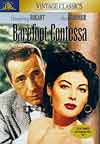The Barefoot Contessa
MGM Home Entertainment
Cast: Humphrey Bogart, Ava Gardner, Edmond O’Brien, Rossano Brazzi
Extras: Theatrical Trailer
Rating:
Joseph Mankiewicz’s ’The Barefoot Contessa’ represents something of an ill-fitting hybrid. The lighting-fast quips and juicy bon mots are signature Mankiewicz and 1950’s American cinema, yet the pacing and storytelling manner are very much of European films of the period. MGM Home Entertainment recently released ’Contessa’ on DVD in a decent movie-only edition.
Told in flashbacks, ’Contessa’ spins the sad tale of one Maria Vargas (Gardner), a Spanish dancer earning her keep in seedy Castilian cafes. Spotted by a despotic producer (Warren Stevens), Maria is groomed to star in his new film. Under the sympathetic paternal tutelage of American film director Harry Dawes (Bogart), Maria becomes a huge international success. Unfortunately, as Harry knows all too well, the road to superstardom is fraught with moral peril. Torn between familial duty, the pressures of fame and her own hunger for love, Maria soon finds that passion and prominence can destroy when mixed.
Any similarity between ’Contessa’ and the far superior ’All About Eve’ made four years earlier ends with Mankiewicz writing and helming both efforts.
True, they both examine the entertainment industry: the legitimate stage in ’Eve’ and filmmaking in ’Contessa’. With the ever-reliable Bogie underplaying Dawes’ tortured sagacity and Gardner’s natural smoldering intensity burning up the lens (not to mention our current national obsession with ’entertainment news’), ’Contessa’ should seem more contemporary than ’Eve.’ Yet for all its heightened speech and acting styles, ’Eve’ has withstood the passage of time. It’s faster, funnier and more assured.
Colors on the full screen transfer are quite vibrant, slightly but effectively saturated. Many scenes exhibit a soft haze, owing to Jack Cardiff’s delicate Technicolor cinematography. Deep blacks and excellent contrast balance create a consistently sharp and clean image. The source elements display a few blemishes, but not to distraction. I detected no edge enhancement, remarkable given the diffused look, and no digital artifacts.
The two-channel mono audio performs on par for an older film. Dialogue plays without distortion when filtered through the center channel. However, overall fidelity is a little thin, the music sounding tinny at times. Depending on your home theater setup, the audio might stray too far from the visual. The same technical observations for the feature presentation apply for the theatrical trailer included on the disc: superb picture, average sound.
The verdict? The performances captivate, the tart-tongued script frequently awes and the transfer stuns but throughout I felt like I was watching a relic of another era rather than a living document. I recommend the DVD to fans of Bogart, Gardner or Mankiewicz, if only for a night.







